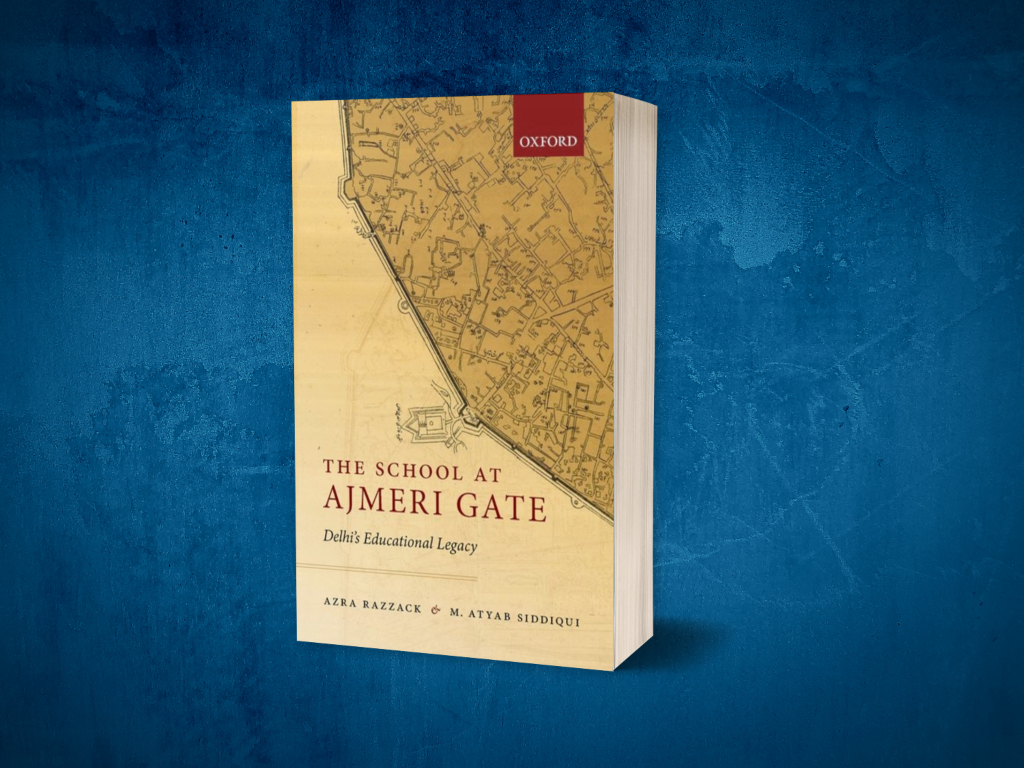
The School at Ajmeri Gate: Delhi’s Educational Legacy by Azra Razzack and M. Ayyab Siddiqui, published by the Oxford University Press in 2022 engages in the unique exercise of exploring the question of the meaning of education within the walled city of Delhi for Muslims through the telling story of one institution. This text documents the life of the Anglo-Arabic school which has been “ghettoised” and marginalised within the larger educational scholarship about Delhi. This is a journey of a three-hundred-year-old educational institution located in the larger history of Muslims in Delhi- from the heyday of the Mughal empire, growth during colonial times, to the influence of Muslim League politics. Further, to partition and the following retributive violence on Muslims who stayed back, to slowly asserting as a community within the Indian state. The larger histories of the society engulf the history of the little institution (Forward). Its history thus symbolises the Muslim past and present (p. 17).
The history of the institution is covered from its founding of religious learning Madrasa Ghaziuddin in 1872, the Delhi College and the Anglo Arabic in the campus to the current times till 2014. The authors are not only scholars are also insiders in the school administration, though they write after their administrative commitments end in 2014. Their effort is to provide voices for various stakeholders including alumni, parents and school children of this historic institute while providing a critical social history. The primary sources include official archival records like administrative letters, reports, school inspectors’ records and a rich collection of college and school magazines along with textual recollections of alumni in the colonial and early post-independence period. For the contemporary period, the authors draw from oral recollections of past teachers, and alumni, newspaper articles, interviews with parents and students, and the author’s own experiences of engaging with the institutions as administrators are used as sources.
The core questions that are addressed concern the shifting priorities of the school and those who were privileged within them, and what the negotiations with the state and the larger Muslim community in the city were. The school simultaneously had to contend with a state which aided it and wanted to challenge its Muslim character. The strong community-school linkages meant that all major decisions had to be weighed against what was seen as acceptable to them. The chapters of the book are divided into two sections, the first explaining the history of the campus before Indian independence and the tempestuous period after partition, and the second exploring the institution’s history in the period after independence when the school campus changes its core identity as Muslim institution to the modern times. All through the text, the ever-changing relationship between the triad of the school, the community/quam and the walled city is traced placing the institute within the socio-geographic context influenced by larger political history.
The book succinctly captures the nostalgia associated with the institution and the almost daily negotiations that are required with a multitude of stakeholders to not only keep the institution afloat but also have periodic reforms towards improving its functioning. The challenges faced by the institution through the years are many, but what stands out is the crisis of identity following partition as the school reopened in 1948 and the role of the “Old Boys” (alumni of the school) and teachers to slowly recover from the loss of its Muslim identity towards a “secular” one while acknowledging its Muslim character. The changing pages of the school and Delhi College magazines ascertain this churning. Also captured are the everyday negotiations of an often-cornered school administration, between bureaucracy and demands of the community, who try to bring about changes in the 2000s – infrastructural, reformatory like an admission of girls and academic – to give new life to a school which was relegated as a lost cause by many.
This historical study adds to the scholarship on institutional exploration of educational sites. It is unique as the academic rigour is combined with the insider knowledge of authors along with a commitment towards the most vulnerable of the stakeholders of the school in contemporary times. One can come back to the central question of how priorities are set and who is privileged, as the Muslim “gentry” moved away from the institution like the upper caste flight from public schools and the school being seen as an aspirational space for largely working class (Bahujan) Muslims. Within the precarity of hyper-nationalism and othering of Muslims, and state withdrawal from public education, the challenges to the institution are many but it is also a ray of hope for the most marginalised among the community. The embracing of constitutional ideals like reservations for Scheduled Caste and Scheduled Tribe staff which the school has resisted on account of being a minority institution could provide it more democratic character as a public institution, just like the opening of the school for girls in 2012. The rich detailing of the school’s history does fulfil the aim of the book authoritatively placing the school within Delhi’s education legacy.
***
Sreejith Murali is a PhD Research Scholar at the Department of Humanities and Social Sciences Indian Institute of Technology (IIT) Bombay.
Indeed, such academic works always contribute in the real knowledge and understanding in the context of past present and for future social policy formulations. Thanks for the contribution.